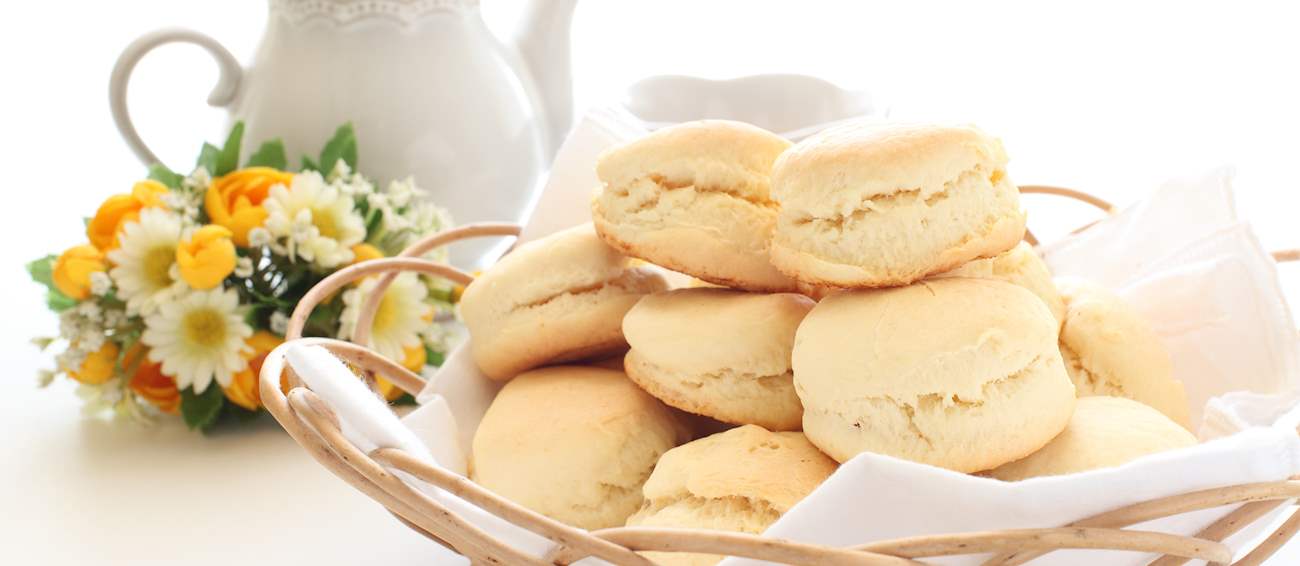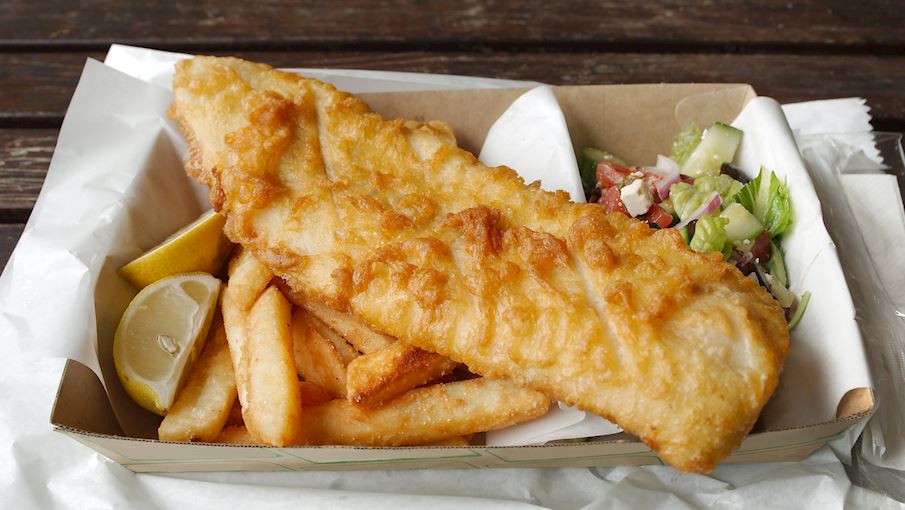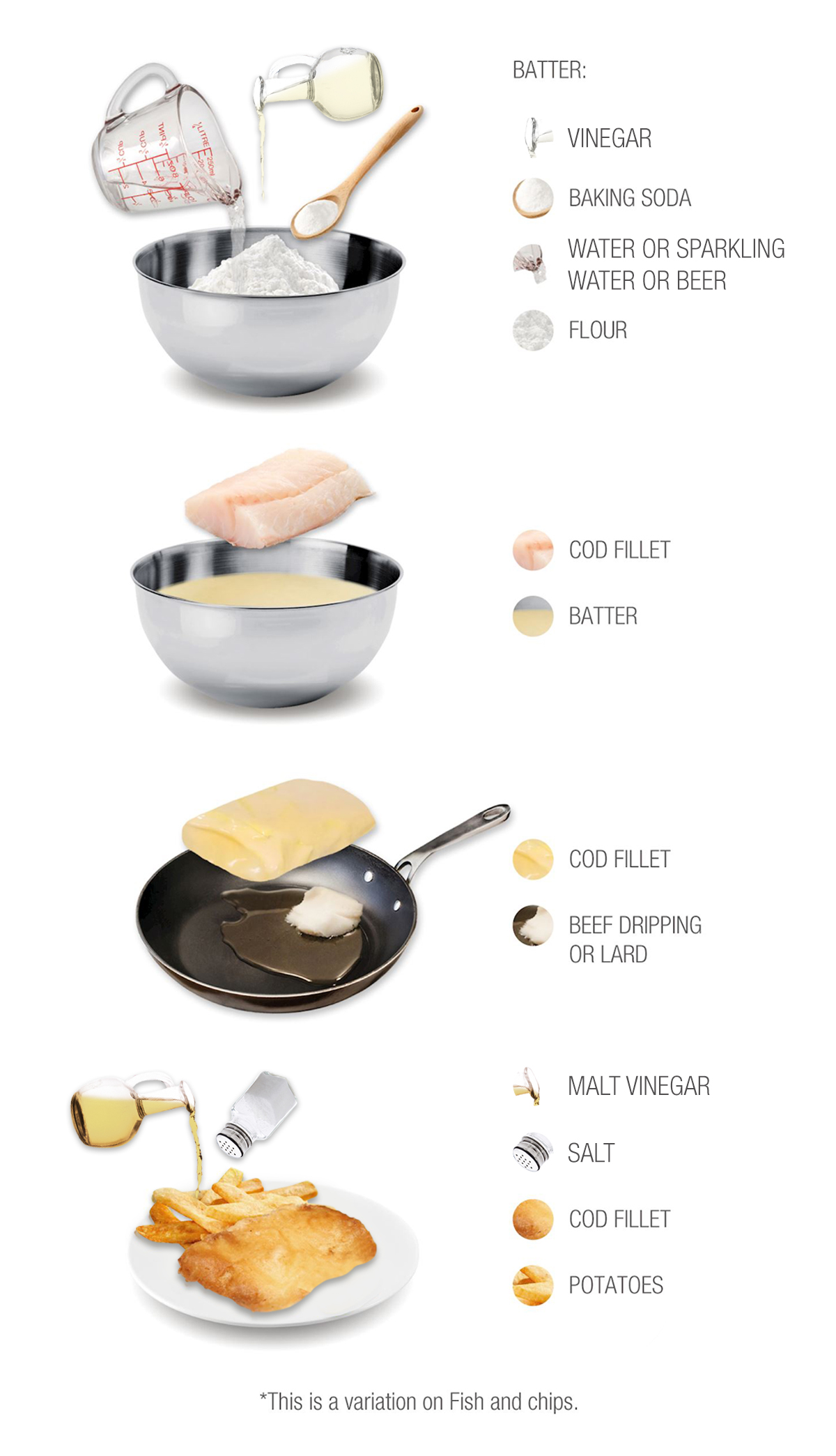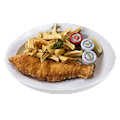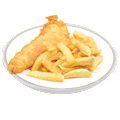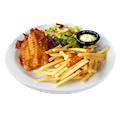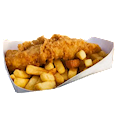Most Brits would agree that there is nothing more British than fish and chips. This comforting, widely loved national dish consists of a freshly fried, hot, white fish fillet and large, sliced and fried potatoes. Cod, haddock, and flounder are the most common types of fish that is fried for the dish, and the customers can choose which type of fish they want, with cod being the most popular choice.
The fillets get dipped in a batter made from eggs, milk, and flour, and are then fried in oil, lard, or beef drippings along with the potatoes. The origins of this dish go back to the 17th century, when potatoes were fried as a substitute for fish in the winter months, while fried fish was introduced into the country by Jewish refugees.
VARIATIONS OF Fish and chips
MAIN INGREDIENTS
Scone is a quick bread that is shaped into various forms such as squares, diamonds, and triangles, then baked in the oven. Although scones were griddle-baked and made with oats in the past, today they are traditionally made with wheat flour, baking powder or soda, butter, milk, sugar, and eggs.
They can be either savory or sweet, consumed for breakfast, or served with afternoon tea. The most popular theory about their origin says they originated in Scotland in the early 1500s, the name scones derived from the Stone of Destiny, where the Kings of Scotland used to be crowned.
VARIATIONS OF Scone
MOST ICONIC Scone
View moreKnown in full as bashed neeps and chappit tatties - mashed swedes and chopped potatoes, respectively - this simple vegetable side dish is a true Scottish classic. Either steamed or boiled until tender, only separately, both the swedes and potatoes are seasoned with merely salt and white pepper, though some might add a dash of nutmeg as well.
Neeps and tatties are traditionally prepared as accompaniments to haggis and make for an essential part of the festive Burns Night supper.
MOST ICONIC Neeps and Tatties
View moreOriginally a harvest festival version of a much simpler oatmeal gruel, cranachan is a traditional cream cheese dessert that became prominent in the late 20th century. It is made with the addition of local soft cheese and often fresh fruits such as raspberries.
The basic modern version of this dessert is based on lightly toasted coarse oatmeal and whipped cream, sweetened with either honey or sugar. In restaurant versions, cranachan may be made with a whole variety of different ingredients, including the beloved Scotch whisky.
MOST ICONIC Cranachan
View moreMAIN INGREDIENTS
Sticky toffee pudding is a rich, moist sponge cake filled with dates, covered in a sticky toffee sauce. The dessert is traditionally served with custard or a scoop of vanilla ice cream on the side. Its origins are quite murky as some claim it originates from the Sharrow Bay Hotel in the Lake District, some report that it's especially popular in Cartmel, while others say that it was invented at the Udny Arms Hotel in Aberdeenshire.
Today, the dessert is also popular in Australia, Ireland, and Scotland.
Haggis is a spicy mince, a type of pudding of high nutritional value made from sheep's innards, lamb's heart, lungs and liver, beef, onions, oats, and spices. It is the national dish of Scotland and an excellent source of fibre, iron, and carbohydrates.
According to some, the word haggis stems from the French word hacher, meaning to chop up or mangle. Originally, it was a poor man's meal made with liver and kidneys stuffed in intestines, providing a good way to feed a lot of people so that no meat would go to waste.
MOST ICONIC Haggis
View moreDrop scones, also known as Scotch pancakes, are small, thick pancakes, made by dropping spoonfuls of batter onto a hot griddle or a frying pan. Originally invented in Scotland, these fluffy treats quickly spread throughout the British Isles - Queen Elizabeth herself is very fond of drop scones - allegedly, she even prepared them for President Dwight Eisenhower during his visit to Balmoral Castle in 1959.
Drop scones make a perfect breakfast, and they are best enjoyed warm. Although drop scones are very simple, when drizzled with honey or paired with cream and sweet fruits, they can easily be turned from a simple breakfast to an irresistible dessert.
Deep-fried Mars bar is a famous Scottish delicacy and a champion of the jokingly-called Scottish Diet, where the rule is that sugar, fat, and alcohol must each account for at least 30% of a person's daily caloric intake. The unusual snack was invented in 1992 by the employees of the Carron fish bar in Stonehaven, a place where the popular fish and chips are served, and the deep-fried Mars chocolate bar (nougat and caramel coated in milk chocolate) is made in the same oil that the fish and chips were fried in.
However, this dessert became a Scottish tradition and was then copied in chip shops all across the country, and it even spread to Canada and Australia. One batter fits all - fish, chips, and the Mars bar. The batter is made by mixing milk, flour, and eggs.
Even though it has been traditionally prepared all along the coast, Cullen skink is a dish originating from the fishing village of Cullen in Northeastern Scotland. This thick and creamy fish soup is typically based on smoked haddock cooked with milk, leeks, onions, and potatoes which provide the filling bulk.
Some recipes specify the use of Arbroath smokies, although just about any smoked white fish will do. Cullen skink will go hand in hand with a glass of dry white wine, but to indulge in a true Scottish feast, try pairing it with Scotch whisky.
The peculiar name of this dish is said to recall the Victorian era Edinburgh which was nicknamed Auld Reekie or Old Smokie because of the coal fires that plagued the city with an intense, dark smog. Often described as a Scottish take on the traditional Eton mess trifle, Edinburgh fog is a decadent dessert made with ratafia biscuits or macaroons, double cream, toasted almonds, and whisky.
It was originally conceived to make use of the leftover scones, but most modern recipes use any kind of almond-flavored biscuits, while whisky can be substituted with the Drambuie liqueur.
